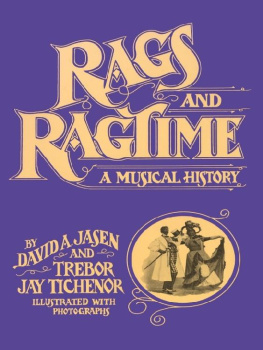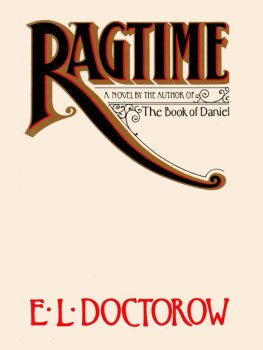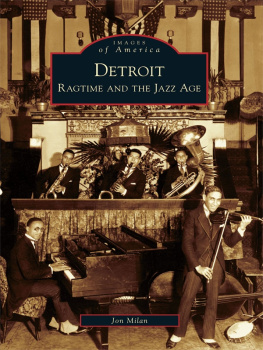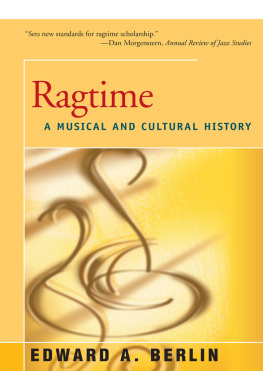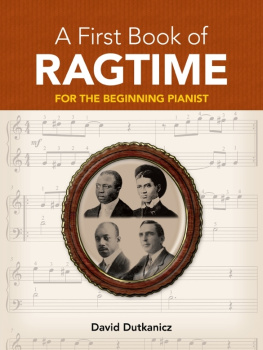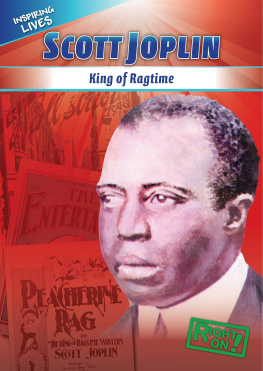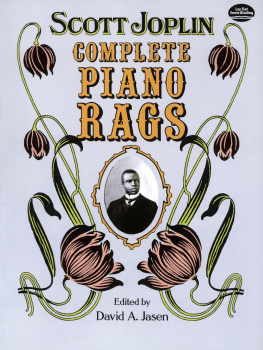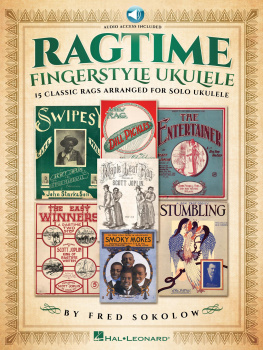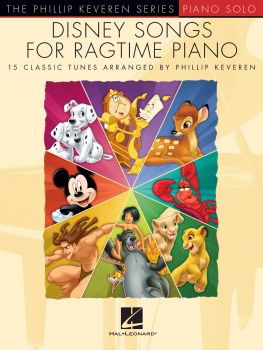D AVID A. JASEN is Chairman of the Department of Communication Arts and Director of the Popular Music Archive at C. W. Post campus of Long Island University. His other books include Recorded Ragtime, 1897-1958, the first major discography dealing with ragtime on 78-rpm records; the Dover anthologies Ragtime Gems, Alexanders Ragtime Band and Other Favorite Song Hits, 1901-1911, and Scott Joplins Complete Piano Rags; and the recently published Tin Pan Alley. He is much sought after across the country as a ragtime pianist and lecturer.
T REBOR JAY TICHENOR owns the worlds largest collection of ragtime piano rolls. He has edited two Dover anthologies, Ragtime Rarities and Ragtime Rediscoveries . He is a founding member of the St. Louis Ragtimers, and he teaches the history of ragtime at Washington University.
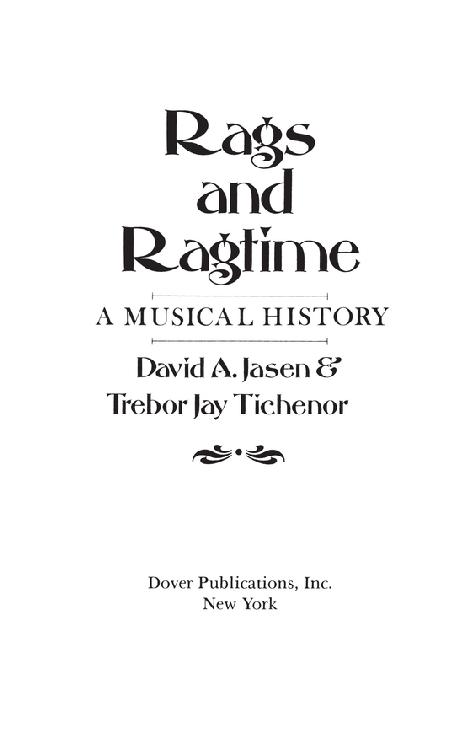
The photographs used in this book have been provided from the authors personal archives, with the following exceptions: the St. Louis parlor in the photo insert section following p. 76, courtesy of Fred and Joe Mazzulla Collection; Rifkins Joplin rags album cover in the photo insert section following p. 250 1970 Nonesuch Records; cover art: Saul Lambert; cover design and art direction: Robert
L. Heimall.
Copyright 1978 by David A. Jasen and Trebor Jay Tichenor. All rights reserved.
This Dover edition, first published in 1989, is an updated
and slightly corrected republication of the edition
originally published by The Seabury Press, New York, in 1978.
Library of Congress Cataloging-in-Publication Data
Jasen, David A.
Rags and ragtime.
Reprint. Originally published: New York : Seabury
Press, 1978. (A Continuum book).
Includes index.
1. Ragtime musicHistory and criticism.
I. Tichenor, Trebor Jay. II. Title.
[ML3530.J37 1989] 781.57209 88-30970
9780486144573
Manufactured in the United States by Courier Corporation
25922602
www.doverpublications.com
To our wives,
Susan Jasen and Jeanette Tichenor,
and our children, Raymond Jasen
and Virginia and Andrew Tichenor,
for their constant
encouragement and help.
Table of Contents
List of Illustrations
FOLLOWING PAGE 76
Max Hoffman
Rag Medley sheet music
Four Songs
Oh, I Dont Know, Youre Not So Warm sheet music
Tom Turpin with story
Turpin story
The madam, girls and possibly Charles Hunter in a
St. Louis parlor
Tom Turpin in front of Rosebud
The House of Lords
Chestnut Street
Louisiana Rag
A Tennessee Jubilee
Dill Pickles sheet music
Porcupine Rag sheet music
12th Street Rag record label
Les Copeland PR label
12th Street Rag sheet music
Car-Barlick Acid sheet music
Harry Belding
John Stark
The Masterpiece Grand Concert Rag advertisement
Joplin/Stark agreement on Maple Leaf Rag
FOLLOWING PAGE 172
Maple Leaf Rag with Joplin sheet music
Piano roll label of Joplins own Maple Leaf Rag
Maple Leaf RagBluebird record label
Joplin in Europe story
Chauvin listing in story
On the Pike sheet music
Frog Legs sheet music
American Beauty sheet music
Stark ad
Charles Daniels
Jerome Remick
Ted Snyder
Wild Cherries sheet music
Chatterbox Rag sheet music
Red Pepper sheet music
Minstrel Man sheet music
Heavy on the Catsup (photo of Lewis Muir)
Julia Lee Niebergall
Egbert Van Alstyne
Jean Schwartz
Bunny Hug Rag sheet music
Soup & Fish Rag sheet music
Nat Johnson
Gold Dust Twins sheet music
Julius Lenzberg
Sid Le Prottis shoeshine parlor
FOLLOWING PAGE 250
Circle Label
QRS label of Charley Straight rag
Fred Heltman
Irwin P. Leclere
Luella Anderson Piano Contest story
Ragging the Scale sheet music
Stumbling paraphrase sheet music
Jack Mills
Kitten on the Keys record label
Original Kitten on the Keys sheet music
Advertisement of original Kitten sheet music
Jack Robbins
Imperial Roll label of Bargy rag
Edythe Baker at piano
Honky Tonk Piano LP cover
Joe Fingers Carr, Jasen and Tichenor
Mississippi Valley Ragtime LP cover
Rompin Stompin Ragtime LP cover
Slugger Ryan LP cover
Joshua Rifkins Joplin rags LP cover
The Entertainer LP cover
The Ragtime Review
The Rag Times
The Ragtimer
Eubie Blake and Dave Jasen
Acknowledgments
T his work is the culmination of more than twenty-five years of constant study, research, collecting and performing by both of us, individually. Because, until recently, ragtime was not considered a subject worthy of formal study, libraries and other traditional information sources could not be used. Our personal collections of original artifacts, sheet music, catalogs, trade publications, piano rolls and flat disc recordings formed the basis of this book. It is, therefore, most appropriate to give thanks to those dealers who, over the years, took special pains to provide us with these materials: Helen W. Cole, Bly Corning, Beverly Hamer, Lillian and Dulcina McNeill, William Russell, Michael Schwimmer, Tom Kraeuchi and Les Zeiger.
Throughout the years, interviews with survivors of the period helped to make real the times during which ragtime flourished. We are especially grateful to the late Arthur Marshall, the late Joe Lamb, the late Charles Thompson, the late Zez Confrey, the late Roy Bargy, and the ever-present Eubie Blake.
We should like to thank Rudi Blesh for making available to us the notebooks filled with the information gathered by him and the late Harriet Janis for their pioneering book, They All Played Ragtime .
It is our good fortune to have so many great friends in the ragtime world on whom we have drawn for information, artifacts, and stimulating company: Richard Allen, Steve Calt, John Rusty David, Sol Goodman, Thornton (Tony) Hagert, Roger Hankins, Joe Lamb, Jr., Max Morath, Dennis Pash, Al Rose, Joe Scotti, Carl Seltzer, Ed Sprankle, Bob Wright, Dick Zimmerman and Bob Darch.
And, finally, our grateful thanks to Mike Montgomery (b. Chicago, Illinois, March 9, 1934), for his generosity in helping to shape the book, in addition to supplying various materials as needed.
I
Ragtime, as a Form and a Fad
R agtime is a musical composition for the piano comprising three or four sections containing sixteen measures each which combines a syncopated melody accompanied by an even, steady duple rhythm. If there is one incontestable statement which can be made about ragtime, it is that ragtime is a paradoxical art form with a perplexing history. In an age of rigid racial divisions, ragtime appeared as a racially ambiguous commodity whose earliest composers had no common racial identity, nor the desire to promote their music under an ethnic banner.
Though ragtime constitutes a concrete musical idiom with more tangible structural features than jazz, its distinguishing musical characteristics were lost upon its early promoters and contemporary listening audience, and, thanks to a long tradition of erroneous commentary on the subject, remain muddled to this day. Although ragtimes compositional history must be discerned mostly through musty sheet music scores, it began as a performance medium. Early ragtime leaders viewed such scores as a point of musical departure, if they were able to read them at all. While ragtimes commercial history is inseparable from mainstream American popular music, where it played a prominent role between 1906 and the First World War, the composer who developed ragtime into a profitable commodity Scott Joplinseemed curiously innocent of crass commercial impulses, and remote from ragtimes lively tradition as a performing art.
By all rights, ragtime should have enjoyed little popularity, for it was far more complex than the competing pop music of its day and demanded rhythmic techniques that lay beyond the grasp of the amateur pianist for whom sheet music was tailored. Yet it not only became a staple of Tin Pan Alley (the clannish New York publishing houses that monopolized the music industry between 1890 and 1930), but proved so popular that the very word ragtime quickly became an indiscriminate label that was used to confer commerciality upon just about any music. But this is yet another paradox, for the original meaning of the word ragtime itself remains undiscoverable.
Next page
